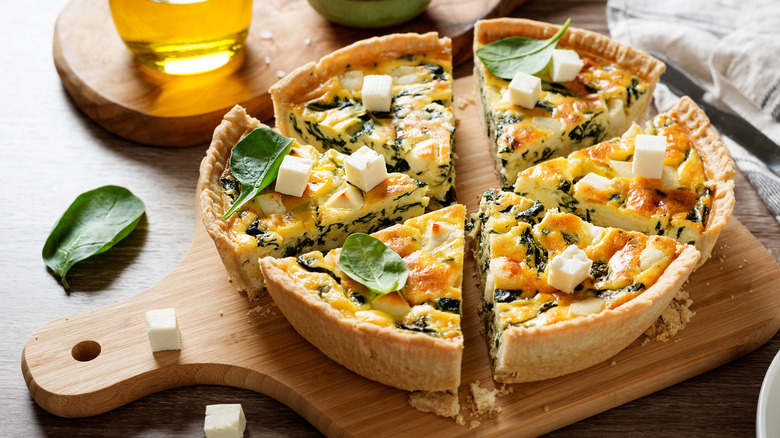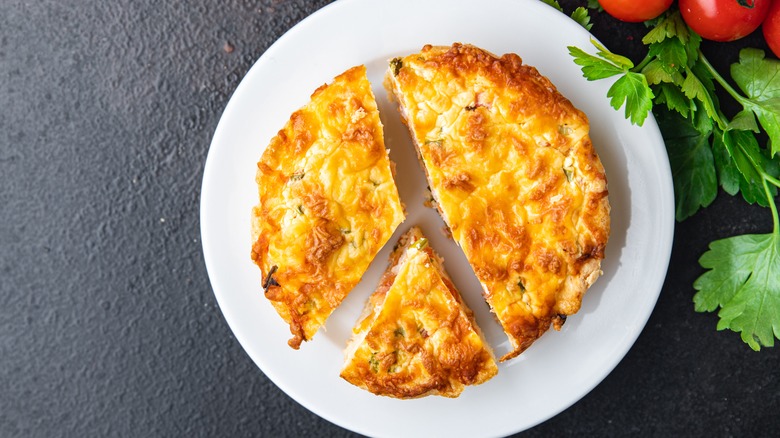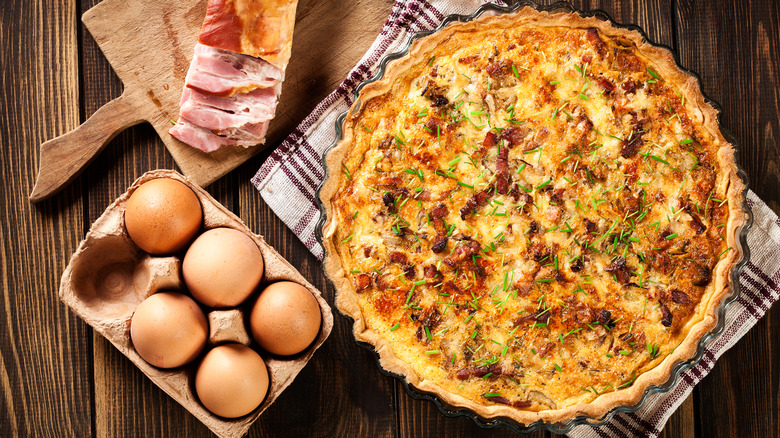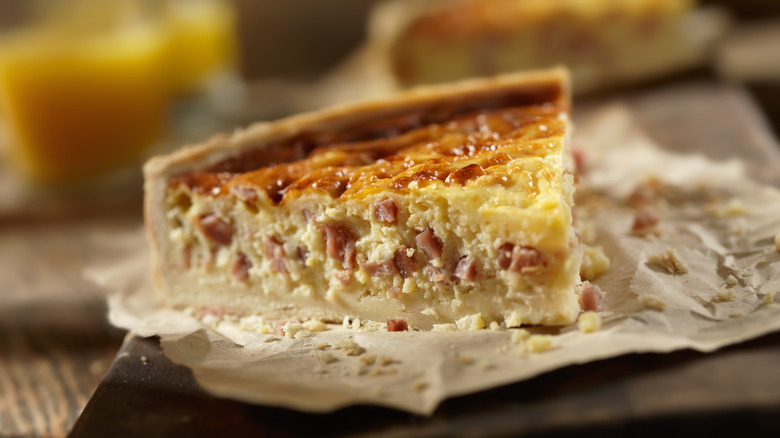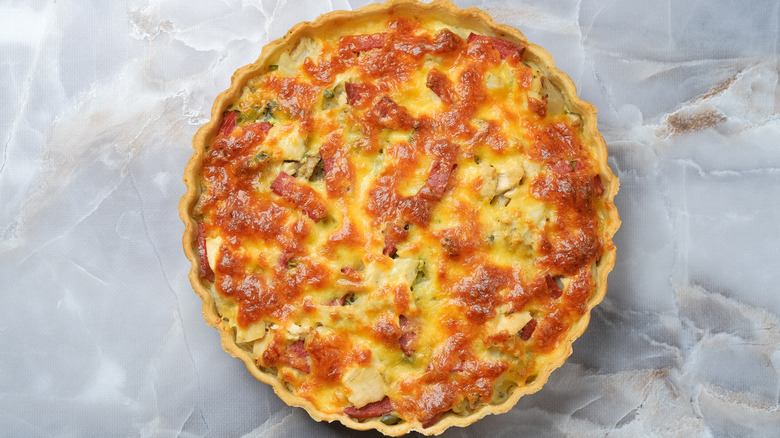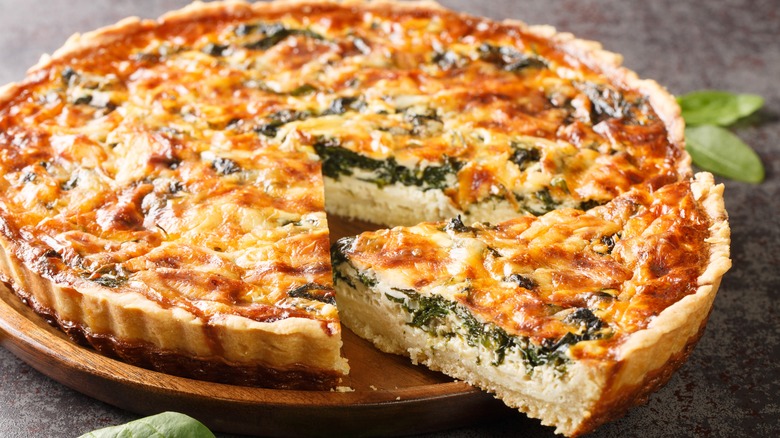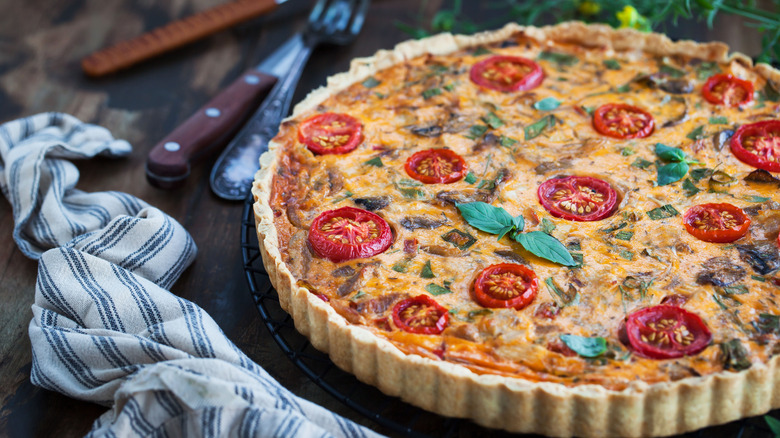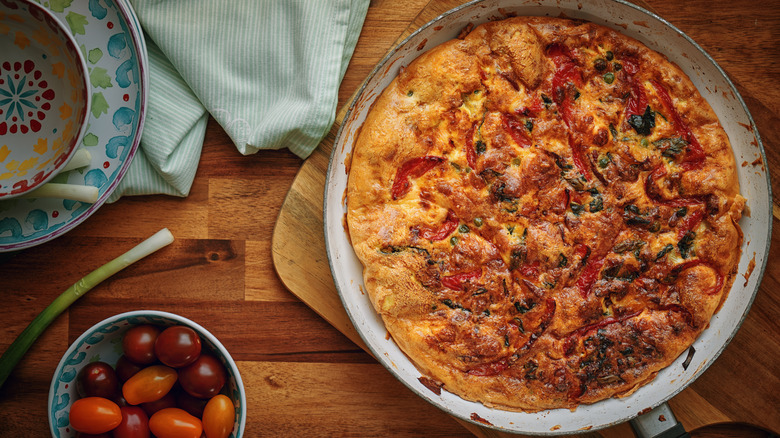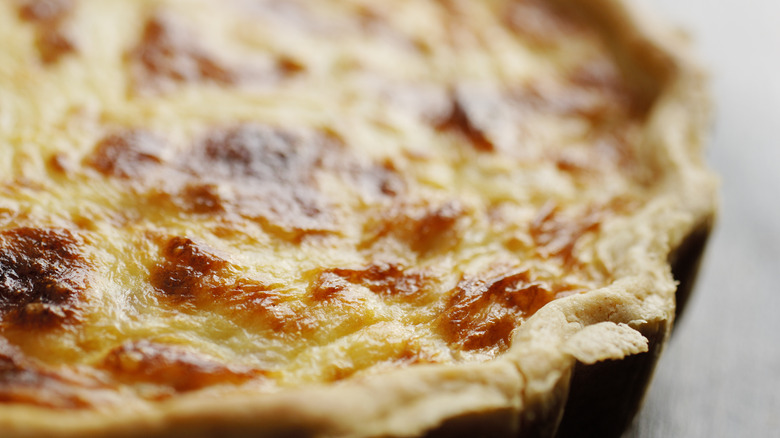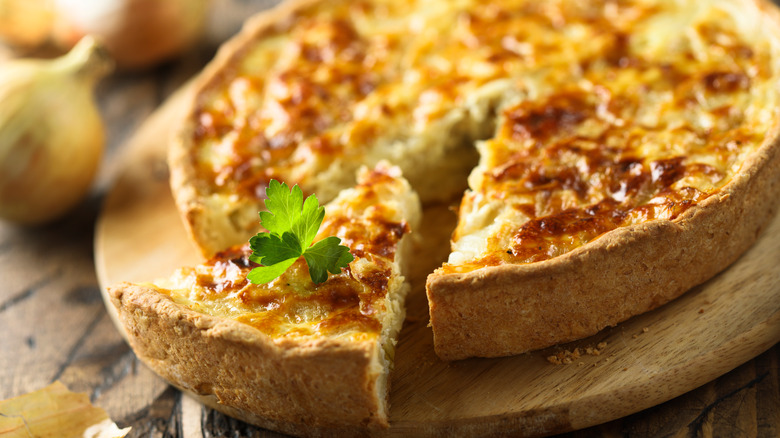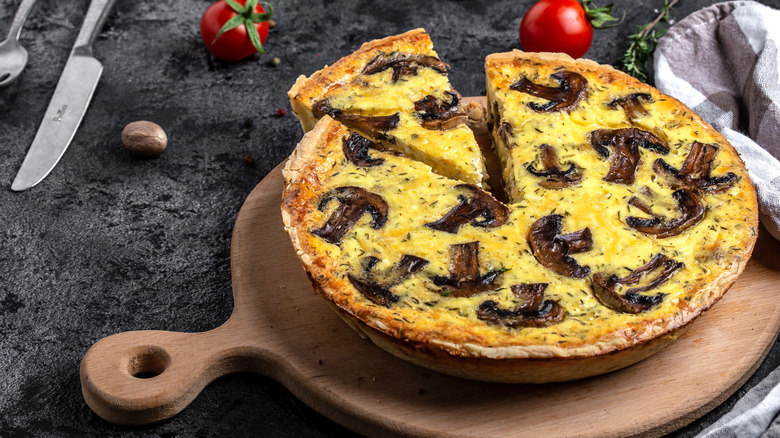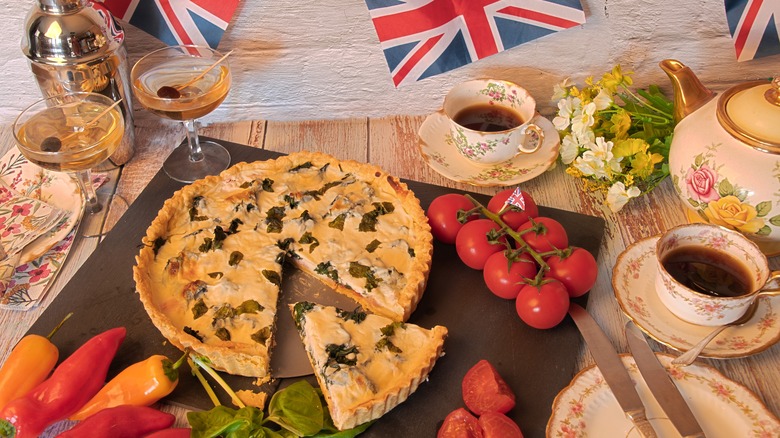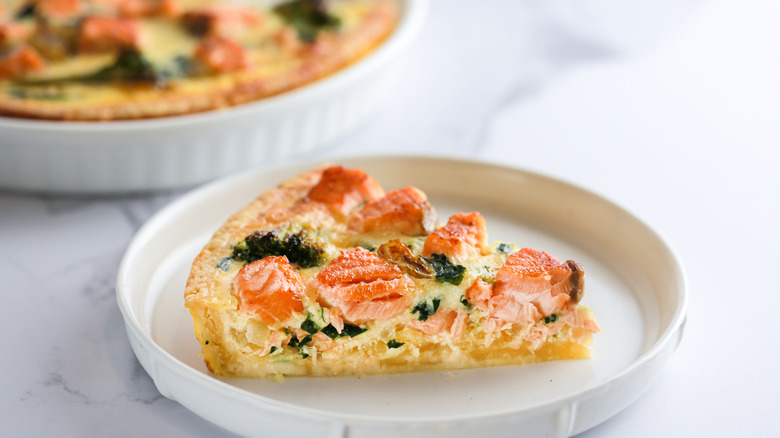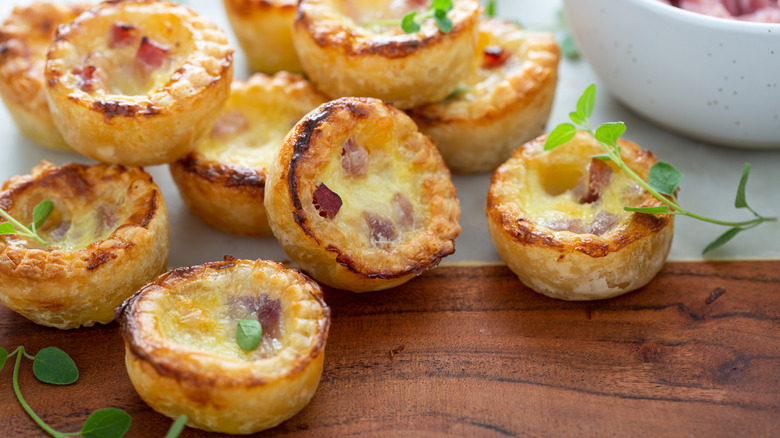13 Quiche Varieties You Should Get To Know
Quiche is a dish that's endured through the ages. While it's most closely associated with French cooking — and the word "quiche" is French — the term actually derives from the German word "kuchen," meaning cake.
This egg dish has been around since the 1400s. Its origins are often traced to the German region of Lothringen, which later became part of the larger Alsace-Lorraine territory. This area has changed from German to French hands many times throughout history, but it's now a part of France.
The original iteration of quiche consisted of a bread crust. It was filled with a mixture of eggs and dairy, also known as custard. Over time, pastry or pie crust took over as the base for quiche, giving the dish a more elegant character. As people continued to enjoy the dish and experiment with it, new and exciting ingredients were added to the filling, creating variations on the basic quiche. Here, we've collected some of the best and most beloved quiche varieties, as well as some you may never have heard of before.
1. Basic quiche
The basic quiche can be considered a blank canvas on which to add other ingredients, but it's also a truly delicious dish that's perfectly enjoyable as is. It may not be as flashy or alluring as some of the other more complex quiches on this list, but it's got a classic, no-frills appeal all its own. Made of only crust and custard, it's deceptively simple on its surface. But both ingredients take time, know-how, and skill to perfect.
Whether store-bought or homemade, really any style of pie crust will work as a base for a basic quiche. You could even make a gluten-free one. Par-baking, also called blind baking, is an important step to ensure your crust doesn't get soggy — that means placing the dough in the pan, weighing it down, and baking it until it's partially cooked through before you add the filling.
The most important thing to know when making your custard filling is the ratio of eggs to dairy. Once you memorize this simple formula, you will be able to whip up a custard anytime the mood strikes. For one large egg, you want to have a half cup of dairy — which can be any combination of milk, half-and-half, crème fraîche, or cream. This will give you an elegant, silky custard. You can then adjust this recipe to your personal preference, adding more eggs for a thicker consistency, if you prefer that style.
2. Quiche Lorraine
Perhaps the best-known of all the quiche varieties is quiche Lorraine. Most modern quiche Lorraine recipes feature bacon and cheese. But the original version did not have cheese. It did have meat, in the form of bacon or ham. As you might intuit from the name, this variety comes from the same region where quiche was invented: the French area of Lorraine (which is no longer called such).
A true quiche Lorraine focuses on the interplay of custard and meat. As for the meat, you can go with any kind of bacon or ham. But for best results, only bacon lardons will do. Lardons are matchstick-shaped pieces of meat that are cut from a slab of cured pork. They are usually thicker than pieces of typical bacon. Since lardons have bigger dimensions, their interiors have more chew to them, while their exteriors are satisfyingly crispy.
You can usually buy lardons from a good butcher. You could also ask for a whole slab of bacon, then cut them yourself. They should be cooked before being added to the quiche filling, as they won't cook properly while swimming in custard. Without adding anything else, the savory meatiness of the bacon lardons compliments the sleek elegance of the custard filling. Together, these two components make a proper and authentic quiche Lorraine.
3. Quiche Vosgienne
Hailing from the same historical, French area as quiche Lorraine, another popular regional specialty is quiche Vosgienne. This is actually the dish that most people consider quiche Lorraine, as it has cheese added to the filling in addition to those delicious bacon lardons. The term "Vosgienne" refers to the Vosges mountain range which runs between the former areas of Alsace and Lorraine, with Lorraine to the west and Alsace to the east.
The typical cheese used in quiche Vosgienne is Gruyère, a semi-firm cow's milk cheese that comes from a town of the same name in Switzerland. This cheese is known for its ability to melt well, thus its inclusion in recipes like this one, where it can meld seamlessly with the custard mixture. It possesses a mild, pleasantly nutty taste that adds a subtle dimension of flavor, without taking too much attention away from other ingredients.
4. Quiche Alsacienne
Yet another variation on the quiche Lorraine is the quiche Alsacienne. It's named for Alsace, the former French region which bordered Lorraine on the other side of the Vosges mountains. This variety is similar to both the Lorraine and Vosgienne quiches but with the notable addition of onions. Typically, the onions are browned or caramelized first, before being added to the filling, giving this quiche a rich and sweet dimension of flavor.
The other major difference you'll find in a quiche Alsacienne, compared to its two siblings, is the type of pork used. Rather than bacon lardons, the preferred meat is speck, which is a particular type of pork that is cured in spices and cold smoked. The combination of intense sweetness from the onions, as well as the savory flavor from the speck, gives quiche Alsacienne a truly unique and complex personality.
While many Alsacienne recipes incorporate cheese, as with the Vosgienne, others omit it, making it more similar to a Lorraine. How long to cook the onions also varies. Some prefer a long caramelization until the onions are deeply rich and softened. Others call for a shorter sauté which results in a more pungent onion flavor.
5. Quiche Florentine
You've probably seen dishes labeled Florentine, or à la Florentine, on many menus. Chicken, eggs, and (of course) quiche can all be prepared in this style. While the term Florentine refers to the city of Florence, Italy, it's actually a French culinary term with a fascinating history.
In the 1500s, the influential Catherine de' Medici moved from Florence to Paris to marry King Henry II. Legend has it that she loved spinach, and her personal cooks created dishes for her that included the leafy green. These recipes ended up being named "à la Florentine" after her hometown. Florentine came to be synonymous with spinach. When dishes are prepared à la Florentine, they are typically also accompanied by a creamy sauce.
Quiche Florentine features spinach front and center, usually along with Gruyère cheese. You'll get the best results if you cook the spinach, then thoroughly drain it before adding it to the filling. This helps get the natural moisture out of the leaves, preventing it from releasing into the filling while the quiche cooks, which can water it down and prevent the custard from setting properly. Spinach adds a vegetal, earthy flavor that contrasts nicely with the rich, creamy custard.
6. Quiche Provencale
If you head further south in France, towards the Mediterranean Sea, you'll reach Provence. This enchanting, sun-drenched region is famous for its seemingly endless fields of lavender, its crisp dry rosé wines, and its deliciously fresh, summery cuisine. Thanks to its warm, sunny climate, lots of delicious and colorful produce thrive here. Many of these herbs and vegetables have made their way into Provence's famous quiche, called quiche Provencale.
Tomatoes are a key ingredient, as well as zucchinis and bell peppers. All of these are also common foods in Provencale cooking. These ingredients are cooked with garlic and onion to add flavor and release moisture before being added to the quiche filling. Another crucial element to giving this quiche its unmistakable Mediterranean flavor is herbes de Provence — a combination of thyme, rosemary, oregano, basil, bay leaf, and other herbs. This can be purchased as a pre-made blend, or you can make your own. These herbs add beautiful aromatics and dimension to the vegetables while enhancing the flavor of the egg custard. Unlike the hearty, rich quality of northern France's regional quiches, this variety has a lighter and fresher character that embodies the spirit of Provence.
7. Quiche Nicoise
Nice is a city located in France. This city is known for a lot of things, including beautiful beaches, art, and sunshine. The town's signature dish is the Nicoise salad. This regional specialty originally consisted of three core ingredients: anchovies, tomatoes, and olive oil. Over time, this salad has evolved to include many other items — most commonly olives, green beans, potatoes, capers, and hard-boiled eggs. Sometimes, tuna is also added. These flavors have become synonymous with Nice. Some are often added to a basic quiche recipe, to create the Nicoise version of the dish.
Tomatoes should be cooked beforehand, to reduce their moisture, before they're added to the quiche. If you're including potatoes, they should also be par-cooked or they may not cook thoroughly in the filling. Anchovies, olives, and capers are briny and salty. If you're using these ingredients in your Nicoise quiche, make sure you're cautious when adding any more salt, as it may not be necessary. To make the dish extra authentic, try to find Nicoise olives. This type of black olive comes from the area.
8. Quiche au fromage
Quiche au fromage, which is a French term meaning cheese quiche, is simple. It consists of a crust, an egg custard, and some cheese. There are no hard and fast rules for quiche au fromage, so this variety can be totally customized to suit your personal cheese preferences. Gruyère is the classic quiche cheese. Similar substitutes include Comté, Emmental, Jarlsberg, or any nutty Swiss cheese. Raclette is another Swiss cheese that's a great choice, as it's made for melting.
Other semi-firm cheeses work well and add their own characters. Some of these include sharp cheddar, mellow Monterey Jack, or sweet Provolone. Soft cheeses like Brie and Camembert can add richness and texture along with a subtle earthy flavor. For an intensely flavored quiche, go for cheeses that are packed with flavor, like a pungent Roquefort or a funky Taleggio.
Even cheeses that don't melt particularly well can add an interesting and tasty dimension to quiche, like crumbles of feta, or hard-aged cheeses like parmesan. A quiche au fromage can focus on one singular cheese — for a focused flavor — or a combination of multiple kinds of cheese — for more complexity.
9. Onion quiche
As a quiche ingredient, onion is incredibly versatile. Depending on the type of onion you use — and how you prepare it before it's added to the filling — this ingredient can provide any number of different flavors, aromas, and textures to your quiche.
Deeply caramelizing onions takes some time and effort. But doing so will imbue a sweet richness and deep, intense flavor to your quiche. White and yellow onions are best suited for this technique. Adding raw, chopped onions is another choice. While they will cook somewhat as the quiche bakes, they'll still maintain some of their sharpness. Red onions are a great option for adding raw, due to their lively, spicy flavor. Shallots add a subtler, slightly garlic-like taste, whether they're cooked or raw.
Possibly the best option for quiche is the leek. While not technically a type of onion, this related vegetable still tastes like one. This ingredient shows up frequently in French cooking. Its onion-like flavor is pleasantly mild, especially when cooked — and it cooks well using most methods. Make sure to use only the white parts of the stem, as the green tops can be tough and woody. Chopped scallions and chives make a great garnish for a leek or onion quiche. Using a combination of different types of alliums will give this quiche a delicious complexity and intensity.
10. Mushroom quiche
Savory and earthy, mushrooms are a fantastic addition to a quiche. The world of mushrooms is vast, offering a wide variety of options that vary in intensity and character — from mild, white button mushrooms to pungently aromatic, luxurious truffles. As with other vegetables, most mushrooms should be cooked first, so that they don't release their moisture into the filling mixture. Cooking them beforehand also concentrates their flavor. You can also take this opportunity to enhance them with fat and seasonings.
Button mushrooms may not be the most exciting option, but they'll add some fleshy texture to your quiche, along with a subtle flavor. Oyster mushrooms are similarly mild tasting. But they also offer a softer texture and more complexity. Cremini, sometimes called baby Bella, mushrooms are a step up in flavor intensity and make for a solid mushroom quiche. Another step above that are shiitakes, which are loaded with umami and wild woodsy flavor.
You could also use maitakes — also called hen-of-the-woods — which are intensely earthy and hold up well to strong flavors. Chanterelles are gorgeously golden and are nicely complemented by rich ingredients like cream, making them perfect if you're going for a sumptuous, high-end quiche. For full extravagance, rare and almost priceless truffles can be shaved on top of a mushroom quiche. If you like the flavor but don't want to break the bank, truffle-flavored oil, salt, or butter work well.
11. Coronation quiche
To mark the occasion of King Charles III's ascension to the throne of England, a signature dish was chosen: the Coronation quiche. The quiche was chosen as a base recipe, because of its versatility and affordability, allowing celebrants to enjoy this royal dish at any temperature or time of day, share it with friends, and not spend too much money putting it together.
For the filling components, a trio of vegetarian ingredients was chosen. Broad beans, also known as fava beans, give it texture. Spinach is added as well, giving it a Florentine feel. Finally, fresh tarragon adds the bright flavor of anise. It also includes cheese. It's made with cheddar. This is not too surprising, as it's a British type of cheese.
As the coronation ceremony neared, many British notables weighed in with their thoughts on this dish, and reviews were largely mixed. Most found the Coronation quiche to be a fine, yet somewhat unexciting, vegetarian quiche.
12. Seafood quiche
Quiche aux Fruits de Mer, or a seafood quiche, appears in Julia Child's famous cookbook "Mastering the Art of French Cooking." The filling in her recipe calls for onions or shallots cooked in butter, along with crab, shrimp, or lobster, and a splash of wine. Any one of these shellfish, or any combination of the three, works well in this recipe. Though they're not listed, scallops are another delicious shellfish option.
Sweet and succulent, shellfish indeed make wonderful filling additions to quiche. They add a buttery flavor and texture to the already rich dish. But you shouldn't limit yourself to just shellfish. Other types of seafood can make excellent quiche partners, too. Smoked or fresh salmon make an intensely-flavored quiche, with a robust and meaty taste and texture. Smoked trout is another good option if you're going for potency.
If you want to go big, bold, and opulent, you could also consider adding uni — also known as sea urchin — to your quiche. This option has a creamy texture, loaded with umami. Just make sure you're getting it fresh, in season, and from a reputable fishmonger. Top the dish with a dollop of caviar to make it extra luxurious.
13. Mini quiches
Any of these wonderful quiche varieties can be made in miniature form, making them a great choice for cocktail parties, brunches, or other gatherings. Little hand-held quiches make excellent finger food, as they have their own shells and need no utensils to enjoy. The only extra tool you need to make them is a muffin tin.
The process is the same as making a full-size quiche, only on a smaller scale, so a few adjustments must be made. The dough can be cut with a cookie cutter so that it fits along in each muffin cup. Then the custard is added — the only thing to keep in mind here is to make sure your filling ingredients are chopped small enough so that they don't take up too much room in each quiche, and can be evenly distributed.
There are a few mini quiche recipes that will work great in your next recipe. Try combining spinach, brie, and bacon, which are deliciously creamy and savory. Then, there's also Hatch chile mini quiches, which are a perfect way to use those spicy peppers when they're in season.
